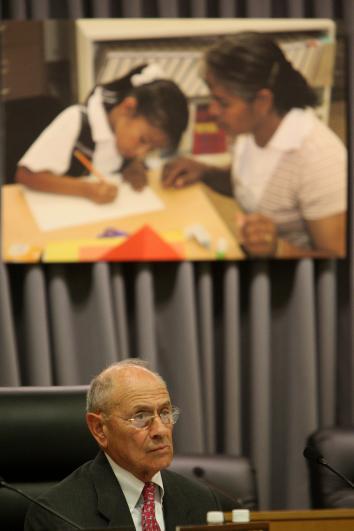It’s one of the biggest debates in education today: What do you do with the unruly students who make learning difficult for the rest of the class? Do you sit them in the corner with a dunce cap, or do you refer them to the counselor down the hall, or do you eject them from school altogether?
Over the past few years, there’s been a nationwide backlash against out-of-school suspensions, which have been shown to affect minorities at disproportionate rates and fast-track some already at-risk children on the school-to-prison pipeline. More and more schools are trying out a more progressive approach to school discipline, with Minnesota and Seattle schools experimenting with bans on out-of-school suspensions for elementary-school students accused of nonviolent offenses. The Houston Independent School District is currently considering a similar ban for students in second grade and below.
As the Los Angeles Times reported over the weekend, the Los Angeles Unified School District was a leader in this movement when it banned out-of-school suspensions for “willful defiance” two years ago. Last year, suspensions in LAUSD hit an impressive low of .55 percent, compared with 8 percent in 2007–08.
But—yes, there’s a big, big but—teachers have also reported an increase in in-class disruptions. It turns out that deciding not to suspend students does not lead to a magical improvement in student behavior. From the Los Angeles Times story:
It’s another day of disruption on this campus in the Los Angeles Unified School District, which has been nationally hailed by the White House and others for its leadership in promoting more progressive school-discipline policies. The nation’s second-largest school system was the first in California to ban suspensions for defiance and announced plans to roll out an alternative known as restorative justice, which seeks to resolve conflicts through talking circles and other methods to build trust. … But many teachers say their classrooms are reeling from unruly students who are escaping consequences for their actions.
If repeatedly sending kids home for nonviolent offenses doesn’t work, what does? Unfortunately, LAUSD hasn’t provided enough schools with a precise answer to that question. Only about a third of LAUSD’s 900 campuses have received the staff and training necessary to implement these new “restorative justice” policies. While those schools have reported mostly positive outcomes, the other 600 are struggling to deal with disruptive students by any means necessary, including calling the police (and we’ve seen all the good that does). As a veteran police officer told the Times, “Now that they can’t suspend, schools want to have officers handle things, but we constantly tell them we can’t do this. Willful defiance is not a crime.”
Ramon Cortines, the LAUSD superintendent who inherited these policies, did not dispute the criticisms about their haphazard implementation, instead offering a somewhat garbled analogy to the district’s embarrassment of an effort to provide iPads for every student:
“I will compare it to the iPad,” Cortines said. “You cannot piecemeal this kind of thing and think it is going to have the impact that it should have. Don’t make a political statement and then don’t have the wherewithal to back it up.”
In other words, you can’t hand a kid a tablet and just expect him to learn from it, and you can’t ignore misbehavior and expect it to disappear. You have to train teachers better on what exactly “restorative justice” entails, and you need more staff in place to work with these kids in school.
